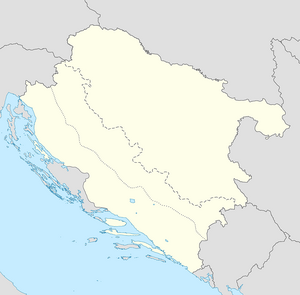| Gudovac massacre | |
|---|---|
| Part of the Genocide of Serbs in the Independent State of Croatia | |
A map of the Independent State of Croatia showing the location of Gudovac | |
| Location | Gudovac, Independent State of Croatia |
| Coordinates | 45°53′16″N 16°46′16″E / 45.88778°N 16.77111°E |
| Date | 28 April 1941 |
| Target | Serbs |
Attack type | Summary executions |
| Deaths | 184–196 |
| Perpetrators | Ustaše |
The Gudovac massacre was the mass killing of around 190 Bjelovar Serbs by the Croatian nationalist Ustaše movement on 28 April 1941, during World War II. The massacre occurred shortly after the German-led Axis invasion of Yugoslavia and the establishment of the Ustaše-led Axis puppet state known as the Independent State of Croatia (NDH). It was the first act of mass murder committed by the Ustaše upon coming to power, and presaged a wider Ustaše-perpetrated campaign of genocide against Serbs in the NDH that lasted until the end of the war.
The Ustaše used the mysterious deaths of two of their local followers as a pretext for the killings. The victims were drawn from Gudovac and its surroundings on 28 April. Most were arrested under the guise that they were rebels loyal to the ousted Yugoslav government. They were taken to a nearby field and collectively shot by a firing squad of up to 70 Ustaše guards. Five of the prisoners managed to survive the initial volley and crawled away to safety. The Ustaše forced Gudovac's surviving inhabitants to dig a mass grave for the victims and pour quicklime on the bodies to speed up decomposition. The following day, relatives of one of the victims informed the Germans of what had transpired. The Germans ordered a partial exhumation of the mass grave, and had 40 suspected perpetrators arrested. Mladen Lorković, a senior Ustaše official, used his influence to have the detained men released and promised German ambassador Siegfried Kasche that the Croatian authorities would carry out a thorough investigation. No investigation took place.
An ossuary and a mausoleum were erected on the site of the massacre in 1955, as was a monument by the sculptor Vojin Bakić. In 1991, amid inter-ethnic violence during the Croatian War of Independence, the monument and the mausoleum were destroyed by Croatian nationalists, as was another one of Bakić's works, Bjelovarac (The Man From Bjelovar). The ruins of the ossuary were removed by the local authorities in 2002. That same year, residents signed a petition to have the Bjelovarac monument erected once again. The restored monument was unveiled in December 2010.
